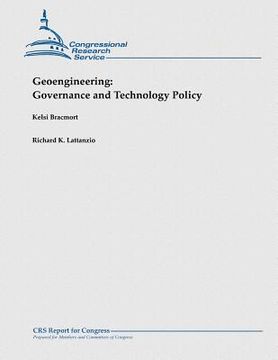Reseña del libro "Geoengineering: Governance and Technology Policy (en Inglés)"
Climate change policies at both the national and international levels have traditionally focused on measures to mitigate greenhouse gas (GHG) emissions and to adapt to the actual or anticipated impacts of changes in the climate. As a participant in several international agreements on climate change, the United States has joined with other nations to express concern about climate change. However, in the absence of a national climate change policy, some recent technological advances and hypotheses, generally referred to as "geoengineering" technologies, have created alternatives to these traditional approaches. If deployed, these new technologies could modify the Earth's climate on a large scale. Moreover, these new technologies may become available to foreign governments and entities in the private sector to use unilaterally-without authorization from the United States government or an international treaty-as was done in the summer of 2012 when an American citizen conducted an ocean fertilization experiment off the coast of Canada. The term "geoengineering" describes this array of technologies that aim, through large-scale and deliberate modifications of the Earth's energy balance, to reduce temperatures and counteract anthropogenic climate change. Most of these technologies are at the conceptual and research stages, and their effectiveness at reducing global temperatures has yet to be proven. Moreover, very few studies have been published that document the cost, environmental effects, sociopolitical impacts, and legal implications of geoengineering. If geoengineering technologies were to be deployed, they are expected to have the potential to cause significant transboundary effects. In general, geoengineering technologies are categorized as either a carbon dioxide removal (CDR) method or a solar radiation management (SRM) method. CDR methods address the warming effects of greenhouse gases by removing carbon dioxide (CO2) from the atmosphere. CDR methods include ocean fertilization, and carbon capture and sequestration. SRM methods address climate change by increasing the reflectivity of the Earth's atmosphere or surface. Aerosol injection and space-based reflectors are examples of SRM methods. SRM methods do not remove greenhouse gases from the atmosphere, but can be deployed faster with relatively immediate global cooling results compared to CDR methods. To date, there is limited federal involvement in, or oversight of, geoengineering. However, some states as well as some federal agencies, notably the Environmental Protection Agency, Department of Energy, Department of Agriculture, and the Department of Defense, have taken actions related to geoengineering research or projects. At the international level, there is no international agreement or organization governing the full spectrum of possible geoengineering activities. Nevertheless, provisions of many international agreements, including those relating to climate change, maritime pollution, and air pollution, would likely inform the types of geoengineering activities that state parties to these agreements might choose to pursue. In 2010, the Convention on Biological Diversity adopted provisions calling for member parties to abstain from geoengineering unless the parties have fully considered the risks and impacts of those activities on biodiversity. With the possibility that geoengineering technologies may be developed and that climate change will remain an issue of global concern, policymakers may determine whether geoengineering warrants attention at either the federal or international level. If so, policymakers will also need to consider whether geoengineering can be effectively addressed by amendments to existing laws and international agreements or, alternatively, whether new laws and international treaties would need to be developed.

